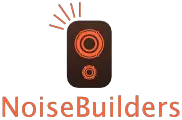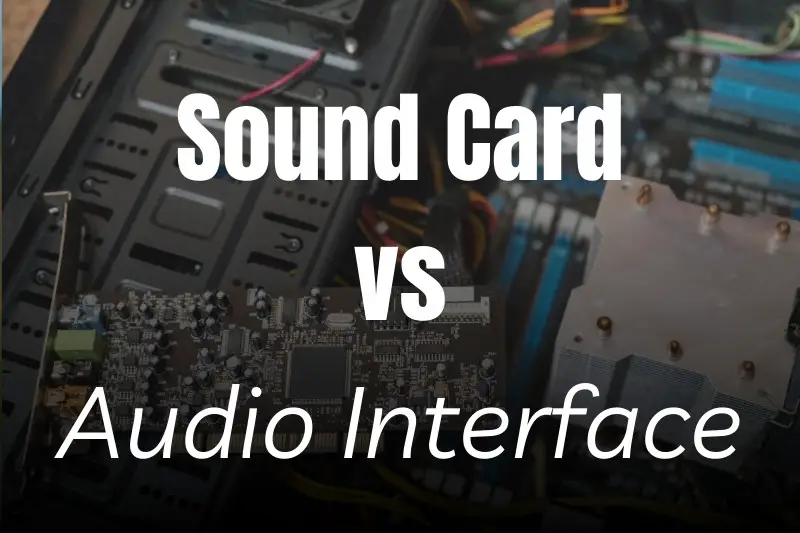As an audiophile and a musician, I’m looking for the best audio quality possible when I’m making and listening to music, recording audio, playing video games, and even watching shows and movies on my computer. Both a sound card and an audio interface are responsible for playing and recording audio on your computer. But, in the sound card vs audio interface debate, can one replace the other?
In theory, sound cards and audio interfaces can replace each other, under most circumstances. There are some differences, such as the need to connect an audio interface with cables while an internal sound card is always connected. But, audio interfaces have benefits that sound cards don’t as well.
The good old days of home music studios and sound cards
Back in the day…we built computers from scratch, by hand. We had to specifically purchase and include everything that we wanted our system to do. If you needed awesome graphics rendering, you had to buy a high-end video card.
If you were going to set up a bedroom music studio, you had to make sure to find the best sound card you could get for the money you had in your wallet.
Names like Turtle Beach and Sound Blaster were the go-to higher-end sound cards for many home recording enthusiasts. These cards would plug into your motherboard and replace the stock sound card. They would then provide inputs and outputs, as well as provide the means to record sound into your computer.
These things were worth their weight in gold.
Getting one of these cards home, cracking open your computer case, and slotting it in made for a very exciting evening. But then you had to download drivers, fiddle with latency issues, and a whole lot more.
Sound cards today
These days, it’s much more common to see the functions of a “sound card” incorporated into the motherboard of a computer or laptop. They’re usually connected in a way that makes it pretty impossible to swap out for something new. So, today, if you’re setting up a bedroom music studio, you’re most likely going to be using an audio interface.
Sound cards have been around for decades and can handle the most basic of sound functions and a lot more. But, because computers are already expensive to build, the cost of making them must be cut somewhere to make computers more affordable.
The sound card is often where some computer manufacturers look for cost savings. This means that the “sound card” that comes with your lower-end PC or laptop might not provide the best audio quality. It’s not really meant to.
To remedy this, you can always opt for an external audio interface. This is what most home musicians and music producers do today. You can also purchase a new sound card to install as long as your computer supports the addition or replacement of one. However, this isn’t all that common anymore.
Do you need a sound card if you have an audio interface?
Both a sound card and audio interface perform very similar functions.
A computer cannot record and play audio without the right tools. Remember, a computer reads audio (and everything else) in a digital format. This format is made up of ones and zeros. Something has to help the computer convert this code to and from analog.
When we record sound into our computer, the analog signal is converted to something digital that the computer understands. When we listen or play back music and sound, the opposite happens. The device that performs this function is either a sound card of some kind or an audio interface.
Generally, you won’t need both devices. In fact, when you plug an audio interface into your computer, you’re providing an alternate pathway for sound than the default one used by your system. Since they perform such similar functions, you really only need one to do the job.
Using a sound card and an audio interface together
If you use an audio interface and a sound card together, the audio interface will completely take over the sound card’s functionality and its respective driver. So, basically, you’re rendering the sound card’s functions useless as the audio interface takes over.
Some systems and DAWs will allow you to choose your input/output as well. But, when you choose your device for input or output, most likely the other option will stop working.
The biggest difference between a sound card vs audio interface is that the sound card is built into your motherboard. The audio interface is a completely external device.
When is an audio interface better than a sound card?
Today, the answer to this is, almost always.
Your end goal, however, does play a big part in answering this question completely. For instance, if you’re simply making beats in Ableton using a keyboard controller and nothing else, you might get away with never needing an external audio interface.
The moment you want to record some actual sound from an instrument like a bass, a guitar, or a voice, you’ll probably need an external audio interface. Also, if you’re looking for very high-quality audio output, you probably want an interface then as well.
What can an audio interface do
An audio interface can often do much more than a simple sound card. And it usually will sound better doing it. While both facilitate the recording and playback of audio, most decent audio interfaces have better recording and playback quality as well as more options for device connections.
A run-of-the-mill sound card’s lower bit depth will be inferior to the high bit depth of a good audio interface. A higher bit depth means better playback and recording quality. Additionally, an audio interface commonly has a built-in preamp that enhances the signal that is then passed on to your recording setup. This can provide a stronger, cleaner sound.
An audio interface usually allows for more than one recording input at a time as well. This function is a very useful feature if you want to record music of superior quality or record with other people.
Essentially, with an audio interface, you can reap the benefit of recording a voice at high quality over a powerful microphone, such as a condenser mic, as well as an instrument that you or a bandmate are playing, such as a guitar.
What are the pros and cons of a sound card?
The pros of a sound card:
- Built-in to your computer’s motherboard, no additional devices or cables are needed for audio.
- Works seamlessly with your system with no setup, drivers, etc.
The cons of a sound card:
- It can only record one input device at a time and not multiple devices simultaneously like the audio interface.
- Unfortunately, the playback and recording of audio are often not high quality.
What are the pros and cons of an audio interface?
The pros of an audio interface:
- An audio interface will provide superior sound quality as opposed to a modern onboard “sound card”.
- It completely replaces the functions a sound card would perform and performs it better.
- Like a sound card, it also allows for converting a digital audio signal to an analog signal for playback and vice versa for recording.
- It has the functionality to record more than one input device at a time.
- Often includes features such as phantom power and much more.
The cons of an audio interface:
- An external device must be bought and connected separately to your computer whenever you want to use it.
- Some of the top-end audio interfaces are very expensive.
What are the recommended audio interfaces to use?
This totally depends on your situation and your budget. An audio interface is a very personal decision for some. There are musicians and producers who go through many different models before they land on the right one.
There are hundreds of choices out there, but here are a couple to get you on the right track:
For the general-purpose producer or musician setting up a home music studio, the Focusrite Scarlett Solo is a fantastic and very popular option. Their 2i2 model is even better if you need multiple inputs.
For the budget-conscious music producers or beginning beatmakers out there, we’ve been playing around with the Donner Livejack audio interface, and we’re impressed. For the money, it’s a fantastic piece of gear.
Sound card vs audio interface: Final thoughts
As “sound cards” and computer systems have both changed so much over the years, you essentially have to replace your sound card with an audio interface if you’re going to produce music on a modern machine.
For musicians, an audio interface will be necessary if you want to record more than one input device at a time, or if you’re looking for recordings that are good quality and above.
The only caveat is that the audio interface is an external device that constantly needs to be connected and disconnected when used and put away.
For audiophiles and musicians alike who are seeking high-quality playback and recording audio, the pros of an audio interface far outweigh its cons.

